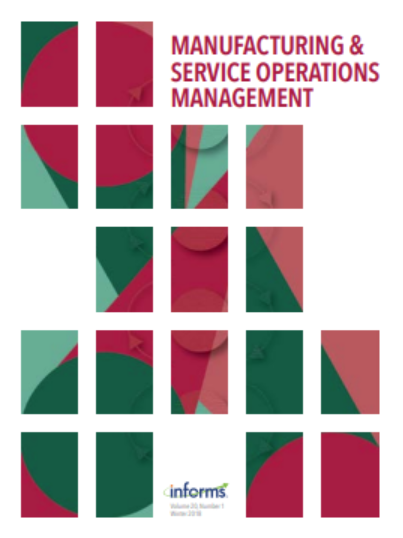Popularity Bias in Online Dating Platforms: Theory and Empirical Evidence
IF 4.8
3区 管理学
Q1 MANAGEMENT
M&som-Manufacturing & Service Operations Management
Pub Date : 2023-10-17
DOI:10.1287/msom.2022.0132
引用次数: 0
Abstract
Problem definition: Generating recommendations of compatible dating partners is a challenging task for online dating platforms because uncovering users’ idiosyncratic preferences is difficult. Thus, platforms tend to recommend popular users to others more frequently than unpopular users. This paper studies such popularity bias in an online dating platform’s recommendations and its consequences for users’ likelihood of finding dating partners. Methodology/results: Motivated by the empirical evidence that a user’s chance of being recommended by the platform’s algorithm increases significantly with the user’s popularity, we study an online dating platform’s incentive that generates popularity bias by modeling the platform’s recommendations and users’ subsequent interactions in a three-stage matching game. Our analysis shows that the recommendations that maximize the platform’s revenue and those that maximize the number of successful matches between users are not necessarily at odds, even though the former leads to a higher bias against unpopular users. Unbiased recommendations result in significantly lower revenue for the platform and fewer matches when users’ implicit cost of evaluating incoming messages is low. Popular users help the platform generate more revenue and a higher number of successful matches as long as these popular users do not become “out of reach.” We validate our theoretical results by running simulations of the platform based on a machine learning–based predictive model that estimates users’ behavior. Managerial implications: Our result indicates that an online dating platform can increase revenue and users’ chances of finding dating partners simultaneously with a certain degree of bias against unpopular users. Online dating platforms can use our theoretical results to understand user behavior and our predictive model to improve their recommendation systems (e.g., by selecting a set of users leading to the highest probabilities of matching or other revenue-generating interactions). Supplemental Material: The online appendices are available at https://doi.org/10.1287/msom.2022.0132 .网络交友平台的人气偏差:理论与实证
问题定义:对于在线约会平台来说,推荐合适的约会对象是一项具有挑战性的任务,因为很难发现用户的特殊偏好。因此,平台倾向于更频繁地向他人推荐受欢迎的用户,而不是不受欢迎的用户。本文研究了在线约会平台推荐中的这种人气偏差及其对用户寻找约会对象可能性的影响。方法/结果:基于用户被平台算法推荐的机会随着用户的受欢迎程度显著增加的经验证据,我们通过对平台推荐和用户随后在三阶段匹配游戏中的互动进行建模,研究了在线约会平台产生受欢迎程度偏见的动机。我们的分析表明,使平台收益最大化的推荐和使用户之间成功匹配数量最大化的推荐并不一定是不一致的,尽管前者会导致对不受欢迎的用户产生更高的偏见。当用户评估传入消息的隐性成本较低时,无偏见的推荐会导致平台的收入显著降低,匹配也会减少。热门用户可以帮助平台创造更多收益和更多成功匹配,只要这些热门用户不会变得“遥不可及”。我们通过运行基于机器学习的预测模型的平台模拟来验证我们的理论结果,该模型可以估计用户的行为。管理启示:我们的研究结果表明,在线约会平台可以增加收入和用户找到约会对象的机会,同时对不受欢迎的用户有一定程度的偏见。在线约会平台可以使用我们的理论结果来理解用户行为,并使用我们的预测模型来改进他们的推荐系统(例如,通过选择一组导致匹配概率最高或其他产生收入的交互的用户)。补充材料:在线附录可在https://doi.org/10.1287/msom.2022.0132上获得。
本文章由计算机程序翻译,如有差异,请以英文原文为准。
求助全文
约1分钟内获得全文
求助全文
来源期刊

M&som-Manufacturing & Service Operations Management
管理科学-运筹学与管理科学
CiteScore
9.30
自引率
12.70%
发文量
184
审稿时长
12 months
期刊介绍:
M&SOM is the INFORMS journal for operations management. The purpose of the journal is to publish high-impact manuscripts that report relevant research on important problems in operations management (OM). The field of OM is the study of the innovative or traditional processes for the design, procurement, production, delivery, and recovery of goods and services. OM research entails the control, planning, design, and improvement of these processes. This research can be prescriptive, descriptive, or predictive; however, the intent of the research is ultimately to develop some form of enduring knowledge that can lead to more efficient or effective processes for the creation and delivery of goods and services.
M&SOM encourages a variety of methodological approaches to OM research; papers may be theoretical or empirical, analytical or computational, and may be based on a range of established research disciplines. M&SOM encourages contributions in OM across the full spectrum of decision making: strategic, tactical, and operational. Furthermore, the journal supports research that examines pertinent issues at the interfaces between OM and other functional areas.
 求助内容:
求助内容: 应助结果提醒方式:
应助结果提醒方式:


